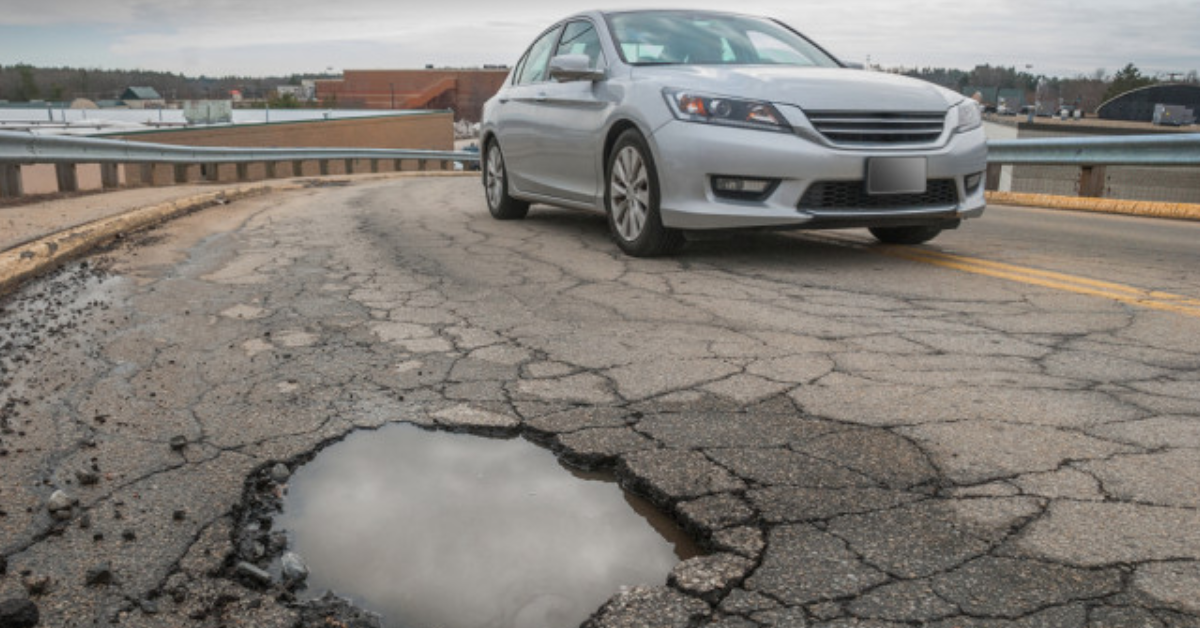
If you’re driving during the day and in conditions of high visibility, spotting and avoiding a pothole is easy—if you’re paying attention, and if the road is relatively empty. But if it’s a dark and stormy night, or if you’re messing with the radio dial, you might hear that sickening “Clunk! Crunch!” that means something bad has happened to your vehicle.
In the vast majority of cases, being startled is the only damage you will incur if you go over a pothole. It might put you in a grumpy mood, but it’s not going to cause any long-term damage. However, if the pothole is particularly deep or if you’re going too fast, you might be left with some dents and scratches on your vehicle—or worse.
Key Takeaways
- While it’s easy to file a pothole damage claim, it may be more trouble than it’s worth and may increase your insurance rates.
- A pothole damage claim is considered a single-car accident, which is filed as an at-fault accident by your insurance carrier.
- Depending on the area you live in, it may be possible to get reimbursement from the county, city, or state that had responsibility for the pothole.
- Whether you are filing a claim with your insurance or the government, documentation is essential.
Pothole damage to your vehicle can easily be extended. Damage to the vehicle’s tires, hubcaps, struts, and alignment can quickly add up, leaving some drivers with repairs costing up to a thousand dollars or more. Filing a pothole damage claim is easy, but whether or not you should do so is something you should consider.
How a Pothole Damage Claim Works
A pothole damage claim is a single-car accident, which is filed as an at-fault accident by your insurance carrier. Hitting a pothole is considered a collision. Your collision deductible will apply, and your rates could go up at your next renewal due to filing an at-fault claim. Sometimes, the damage sustained is a lower dollar amount than your deductible, which would make filing a claim irrelevant.
An Alternative To Filing a Claim
First, determine whether the road is a city, county, or state road. Depending on the area you live in, it’s possible to get reimbursement. Of course, it can be a lengthy process, so be prepared to pay the cost up front.
Note: If your car only suffered some minor dings and scratches (if that), you are definitely better off skipping any official claim process altogether—it’s just not worth the time and energy.
Tips for City, County, or State Pothole Damage Reimbursement
Whether you are filing a claim with your insurance or the government, three things are essential: Documentation, documentation, documentation!
- Take a photo of the pothole at the time of the incident.
- Take a photo of the damage done to your vehicle.
- Note the date and time of the accident.
- Get at least two estimates from two different mechanics
It’s easier to file damage claims in some states than in others. Many states require you to provide proof that the road commission knew of the pothole for 30 days or more and did nothing to repair it.
Prevent Pothole Damage Before It Occurs
Of course, there are several steps you can take that can help you avoid any of this, well before an unfortunate situation happens.
Make sure to pay attention to the road when you’re driving. It’s not just about where you’re going, but also what’s on the ground.
Talk to local officials if there is a problem. If your neighborhood is particularly pothole-riddled, sometimes a few calls to public officials can get the problem fixed, saving you—and countless other drivers—the headache and hassle of pothole damage. Most major cities have a dedicated line for dealing with such complaints, but for small cities, perhaps just going to City Hall will fix the problem. In 2022, the era of social media, a little bit of Facebook or Twitter lobbying never hurt anyone.
Frequently Asked Questions (FAQs)
How much damage can a pothole cause?
Potholes can cause serious damage to your vehicle. If you hit a bad one, you may need anything from a simple flat-tire fix to extensive wheel and suspension repairs.
How can I tell if my car has pothole damage?
After you hit a pothole, check your vehicle for signs of damage. These may include a bulging or flat tire, bent rims, issues driving straight, a low vehicle front end, shaking or rumbling while driving, fluid leakage, or strange noises from the exhaust.
To read the full article, click here.